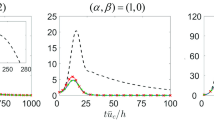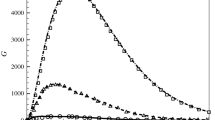Abstract
This work deals with the characterization of the closed-loop control performance aiming at the delay of transition. We focus on convective wavepackets, typical of the initial stages of transition to turbulence, starting with the linearized Kuramoto–Sivashinsky equation as a model problem representative of the transitional 2D boundary layer; its simplified structure and reduced order provide a manageable framework for the study of fundamental concepts involving the control of linear wavepackets. The characterization is then extended to the 2D Blasius boundary layer. The objective of this study is to explore how the sensor–actuator placement affects the optimal control problem, formulated using linear quadratic Gaussian (LQG) regulators. This is carried out by evaluating errors of the optimal estimator at positions where control gains are significant, through a proposed metric, labelled as \(\gamma \). Results show, in quantitative manner, why some choices of sensor–actuator placement are more effective than others for flow control: good (respectively, bad) closed-loop performance is obtained when estimation errors are low (respectively, high) in the regions with significant gains in the full-state-feedback problem. Unsatisfactory performance is further understood as dominant estimation error modes that overlap spatially with control gains, which shows directions for improvement of a given set-up by moving sensors or actuators. The proposed metric and analysis explain most trends in closed-loop performance as a function of sensor and actuator position, obtained for the model problem and for the 2D Blasius boundary layer. The spatial characterization of the \(\gamma \)-metric provides thus a valuable and intuitive tool for the problem of sensor–actuator placement, targeting here transition delay but possibly extending to other amplifier-type flows.























Similar content being viewed by others
References
Åström, K.J.: Introduction to Stochastic Control Theory. Academic Press, New York (1970)
Bagheri, S., Brandt, L., Henningson, D.S.: Input–output analysis, model reduction and control of the flat-plate boundary layer. J. Fluid Mech. 620, 263–298 (2009)
Bagheri, S., Henningson, D.: Transition delay using control theory. Philos. Trans. R. Soc. 369, 1365–1381 (2011)
Bagheri, S., Henningson, D., Hoepffner, J., Schmid, P.: Input–output analysis and control design applied to a linear model of spatially developing flows. Appl. Mech. Rev. 62, 020803 (2009). https://doi.org/10.1115/1.3077635
Bagheri, S., Åkervik, E., Brandt, L., Henningson, D.S.: Matrix-free methods for the stability and control of boundary layers. AIAA J. 47(5), 1057–1068 (2009)
Barbagallo, A., Dergham, G., Sipp, D., Schmid, P.J., Robinet, J.C.: Closed-loop control of unsteadiness over a rounded backward-facing step. J. Fluid Mech. 703, 326–362 (2012). https://doi.org/10.1017/jfm.2012.223
Belson, B., Semeraro, O., Rowley, C., Pralits, J., Henningson, D.: Robustness of reduced-order observer-based controllers in transitional 2D Blasius boundary layers. Bull. Am. Phys. Soc. 64, G14.004 (2011)
Briggs, R.J.: Electro-Beam Interaction with Plasmas. MIT, Cambridge, MA (1965)
Chen, K.K., Rowley, C.W.: \(\cal{H}_{2}\) optimal actuator and sensor placement in the linearised complex Ginzburg-Landau system. J. Fluid Mech. 681, 241–260 (2011)
Chen, K.K., Rowley, C.W.: Fluid flow control applications of \({\cal{H}} _{2}\) optimal actuator and sensor placement. In: American Control Conference (2014)
Chevalier, M., Schlatter, P., Lundbladh, A., Henningson, D.: A pseudo-spectral solver for incompressible boundary layer flows. Technical report (2007)
Chomaz, J.M.: Global instabilities in spatially developing flows: non-normality and nonlinearity. Annu. Rev. Fluid Mech. 37(1), 357–392 (2005). https://doi.org/10.1146/annurev.fluid.37.061903.175810
Colburn, C., Zhang, D., Bewley, T.A.: Gradient-based optimization methods for sensor and actuator placement in LTI systems (2011). https://www.semanticscholar.org/paper/Gradient-based-optimization-methods-for-sensor-%26-in-ColburnZhang/eb6d3f709c5a3301394bf3adbb89cca01923df34
Dergham, G., Sipp, D., Robinet, J.C.: Stochastic dynamics and model reduction of amplifier flows: the backward facing step flow. J. Fluid Mech. 719, 406–430 (2013). https://doi.org/10.1017/jfm.2012.610
Dhingra, N., Jovanovic, M., Luo, Z.: An ADMM algorithm for optimal sensor and actuator selection. In: Proceedings of the IEEE Conference on Decision and Control 2015-February (February), pp. 4039–4044 (2014). https://doi.org/10.1109/CDC.2014.7040017 (2014 53rd IEEE Annual Conference on Decision and Control, CDC 2014 ; Conference date: 15-12-2014 Through 17-12-2014)
Fabbiane, N., Semeraro, O., Bagheri, S., Henningson, D.: Adaptive and model-based control theory applied to convectively unstable flows. Appl. Mech. Rev. 66, 060801 (2014)
Fabbiane, N., Simon, B., Fischer, F., Grundmann, S., Bagheri, S., Henningson, D.: On the role of adaptivity for robust laminar flow control. J. Fluid Mech. 767, R1 (2015)
Farrel, B.F., Ioannou, P.J.: Stochastic forcing of the linearized Navier-Stokes equations. Phys. Fluids 5, 2600–2609 (1993)
Giannetti, F., Luchini, P.: Structural sensitivity of the first instability of the cylinder wake. J. Fluid Mech. 581, 167–197 (2007)
Hiramoto, K., Doki, H., Obinata, G.: Optimal sensor/actuator placement for active vibration control using explicit solution of algebraic Riccati equation. J. Sound Vib. 229(5), 1057–1075 (2000). https://doi.org/10.1006/jsvi.1999.2530
Huerre, P., Monkewitz, P.A.: Local and global instabilities in spatially developing flows. Annu. Rev. Fluid Mech. 22(1), 473–537 (1990)
Illingworth, S.J., Oehler, S.F.: Sensor and actuator placement trade-offs for a linear model of spatially developing flows. J. Fluid Mech. 854, 34–55 (2018)
Jovanovich, M.R., Bamieh, B.: Componentwise energy amplification in channel flows. J. Fluid Mech. 534, 145–183 (2005)
Kim, J., Bewley, T.: A linear systems approach to flow control. Annu. Rev. Fluid Mech. 39, 383–417 (2007)
Lin, F., Fardad, M., Jovanović, M.R.: Design of optimal sparse feedback gains via the alternating direction method of multipliers. IEEE Trans. Autom. Control 58(9), 2426–2431 (2013)
Ma, Z., Ahuja, S., Rowley, C.: Reduced-order models for control of fluids using the eigensystem realization algorithm. Theor. Comput. Fluid Dyn. 25, 233–247 (2011)
Manohar, K., Kutz, J.N., Brunton, S.L.: Optimal sensor and actuator selection using balanced model reduction (2018) arXiv:1812.01574
Nestorović, T., Trajkov, M.: Optimal actuator and sensor placement based on balanced reduced models. Mech. Syst. Signal Process. 36(2), 271–289 (2013). https://doi.org/10.1016/j.ymssp.2012.12.008
Reinschke, J., Smith, M.C.: Designing robustly stabilising controllers for LTI spatially distributed systems using coprime factor synthesis. Automatica 39(2), 193–203 (2003). https://doi.org/10.1016/S0005-1098(02)00198-X
Rowley, C.: Model reduction for fluids, using balanced proper orthogonal decomposition. Int. J. Bifurc. Chaos 15, 997–1013 (2005)
Rowley, C.W., Dawson, S.T.: Model reduction for flow analysis and control. Annu. Rev. Fluid Mech. 49(1), 387–417 (2017). https://doi.org/10.1146/annurev-fluid-010816-060042
Sasaki, K., Morra, P., Fabbiane, N., Cavalieri, A., Hanifi, A., Henningson, D.: On the wave-cancelling nature of boundary layer flow control. Theor. Comput. Fluid Dyn. 32, 593–616 (2018)
Sasaki, K., Tissot, G., Cavalieri, A.V.G., Jordan, P., Biau, D.: Closed-loop control of a free shear flow: a framework using the parabolized stability equations. Theor. Comput. Fluid Dyn. (2018). https://doi.org/10.1007/s00162-018-0477-x
Schmid, P.J., Henningson, D.S.: Stability and Transition in Shear Flows. Springer, Berlin (2001)
Schrauf, G.: Status and perspectives of laminar flow. Aeronaut. J. 109, 639–644 (2005)
Semeraro, O., Bagheri, S., Brandt, L., Henningson, D.S.: Feedback control of three-dimensional optimal disturbance using reduced-order models. J. Fluid Mech. 677, 63–102 (2011)
Simon, B., Fabbiane, N., Nemitz, T., Bagheri, S., Henningson, D.S., Grundmann, S.: In-flight active wave cancelation with delayed-x-LMS control algorithm in a laminar boundary layer. Exp. Fluids 57(10), 160 (2016)
Skogestad, S., Postlethwaite, I.: Multivariable Feedback Control, 2nd edn. Wiley, London (2005)
Sturzebecher, D., Nitsche, W.: Active cancellation of Tollmien–Schlichting instabilities on a wing using multi-channel sensor actuator systems. Int. J. Heat Fluid Flow 24, 572–583 (2003)
Taira, K., Brunton, S.L., Dawson, S.T.M., Rowley, C.W., Colonius, T., McKeon, B.J., Schmidt, O.T., Gordeyev, S., Theofilis, V., Ukeiley, L.S.: Modal analysis of fluid flows: an overview. AIAA J. 55(12), 4013–4041 (2017)
Zare, A., Mohammadi, H., Dhingra, N.K., Georgiou, T.T., Jovanovic, M.R.: Proximal algorithms for large-scale statistical modeling and sensor/actuator selection. IEEE Trans. Autom. Control (2019). https://doi.org/10.1109/tac.2019.2948268
Zhou, K., Doyle, J., Glover, K.: Robust and Optimal Control. Prentice Hall, Englewood Cliffs, NJ (2004)
Acknowledgements
The authors acknowledge Capes for the financial support provided; A. V. G. Cavalieri acknowledges financial support by CNPq (Grant Number 310523/2017-6).
Author information
Authors and Affiliations
Corresponding author
Additional information
Communicated by Daniel J. Bodony.
Publisher's Note
Springer Nature remains neutral with regard to jurisdictional claims in published maps and institutional affiliations.
Appendices
Appendix A: \(\mathcal {H}_{2}\) norm
Given a stable transfer function G(s), the \(\mathcal {H}_{2}\) norm is defined as
where g(t) is the impulse response in the time domain. The equivalence between both expressions is given by Parseval’s theorem.
Writing G(s) in the state-space form
which has m inputs, l outputs and state of order n. The output \(g_{j}(t)\), which corresponds to the jth column of g(t), is the output for the impulsive input \(u_{j}(t)=[\dots \; \delta (t)\; \ldots ]^\mathrm{T}\), which is nonzero only in the jth position, where it has an impulsive forcing. Considering \(q(0)=0\),
where \(B_{j}\) is the jth column of matrix B. Then, Eq. (30) can be written as
where \(P_{O}=\int _{0}^{+\infty }e^{A^\mathrm{T}t}C^\mathrm{T}Ce^{At}\mathrm{d}t\) is the observability Gramian and \(P_{C}=\int _{0}^{+\infty }e^{At}BB^\mathrm{T}e^{A^\mathrm{T}t}\mathrm{d}t\) is the controllability Gramian.
The squared \(\mathcal {H}_{2}\) norm of the system is given by the integral of its output energy in time when it is forced by an impulsive input (30) or by the expected value of the output energy density in the steady state when it is forced by a unit spectral power white-noise forcing.
Given the generalized approach to consider the control of a flow excited by a unit spectral density white-noise forcing, the impulsive response simulation is preferred over the usual attempts to obtain a stochastic forcing. As the latter is not strictly possible, a precise result for the \(\mathcal {H}_{2}\) norm can be obtained only through averaging over several realizations, while (32) can be obtained in a single simulation for a single-input single-output (SISO) system and provide a precise result (Fig. 24). For a multiple-input multiple-output (MIMO) system, m impulsive simulations are needed for the \(\mathcal {H}_{2}\) norm calculation. The expressions (33) can also be a workaround to stochastic simulations.
Output energy power or the squared \(\mathcal {H}_{2}\) norm for the uncontrolled system in Fig. 4 with input \(B_{d}\) and output \(C_{z}\)
To show this equivalence, the result in [18] is developed.
The output for an input u(t) in (31) is
where \(\varPhi _{A}(t,s) = e^{A(t-s)}\). The ith output component is
where \(C_{i*}\) is the ith line of matrix C. The energy E(t) of the measurement of the flow subjected to the actuation u(t) is given by
where
In tensor notation,
where \(\langle \, \rangle \) denotes ensemble averaging. As u is a unit spectral density white-noise forcing,
Let \(P_{O}(t) = \int _{0}^{t}\varPhi _{A}^\mathrm{T}(t,s)C^\mathrm{T}C\varPhi _{A}(t,s)\mathrm{d}s\), \(P_{O} = \lim _{t \rightarrow \infty } P_{O}(t)\) and \(\langle E^{\infty }\rangle = \lim _{t \rightarrow \infty }\langle E(t)\rangle \). Then,
In matrix notation,
Showing
is analogous.
Appendix B: \(\mathcal {H}_{2}\) norm as modes superposition
From (41), performing the singular value decomposition on matrix \(P_{C}\), as in (19)
In tensor notation,
The \(\mathcal {H}_{2}\) squared norm can then be written as
In matrix notation,
where \(C^\mathrm{T}_{*i}\) is the ith column of matrix \(C^\mathrm{T}\).
Showing
where \(B_{*p}\) is the pth column of matrix B and \(\sigma _{o_r}\) and the modes \(\psi _{r}\) come from the singular value decomposition of matrix \(P_{O}\), is analogous.
The expressions (42) and (43) allow the visualization of the \(\mathcal {H}_{2}\) norm as the superposition of matrices C and B with the controllability and observability modes, respectively. Besides, they provide a direct formula to measure the influence of the model reduction on the \(\mathcal {H}_{2}\) norm.
Rights and permissions
About this article
Cite this article
Freire, G.A., Cavalieri, A.V.G., Silvestre, F.J. et al. Actuator and sensor placement for closed-loop control of convective instabilities. Theor. Comput. Fluid Dyn. 34, 619–641 (2020). https://doi.org/10.1007/s00162-020-00537-9
Received:
Accepted:
Published:
Issue Date:
DOI: https://doi.org/10.1007/s00162-020-00537-9





